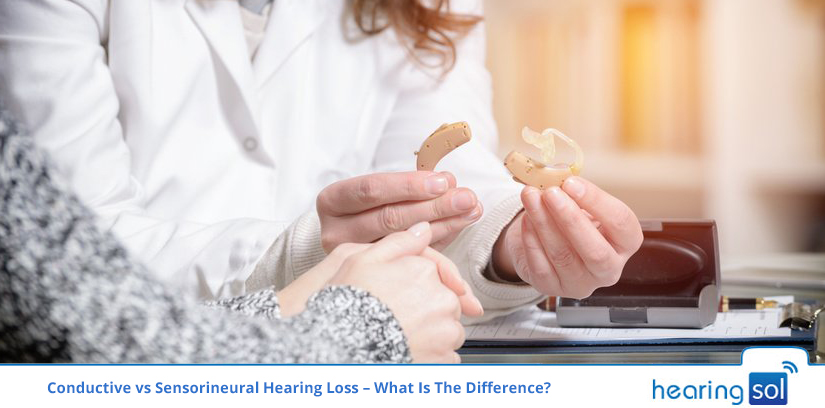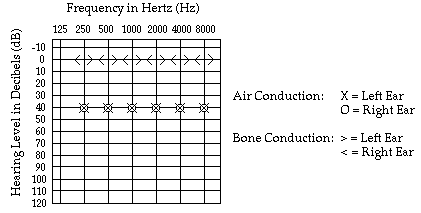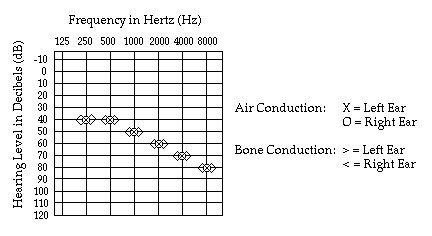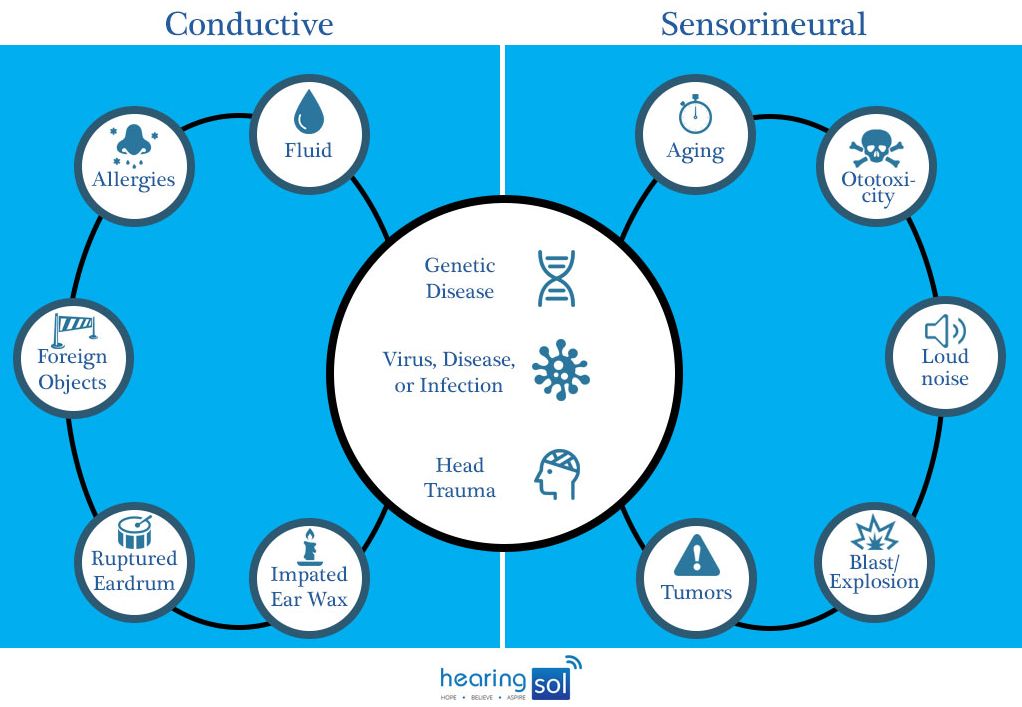
The human ear is just like a small machine where each part works together to enable hearing. To explain, there are four common areas in the human ear i.e outer ear, middle ear, inner ear, and central auditory pathways. Here we will discuss Sensorineural And Conductive Hearing Loss.
You can purchase the latest hearing aids at a fair price through HearingSol, If you need any assistance or you have a query regarding Sensorineural And Conductive Hearing Loss, feel free to call us at +91-9327901950. We are always here to help you.
The sound waves enter the outer ear, then processed into the middle or inner ear and later travel to the brain through the auditory path or nerve. If there is any obstruction at any point in their way, the result is hearing loss.
According to the world health organization, 5% of the world’s population is suffering from the hearing disorder which seems to be small but it covers around 360 million(crore) of people across the globe. This number is increasing day by day whereas, the access to the healthcare centers are limited so, taking care of your health should be the first priority.
Sensorineural and Conductive are the two main examples of deafness. Both of these two are types of hearing loss. This article is all about the major as well as minor differences between conductive vs sensorineural hearing loss.
However, the types of hearing impairment related to the specific parts of the ear and depending on where the sound waves are interrupted.
Such as Conductive deafness is related to the outer or middle ear whereas sensorineural is related to the inner ear. The type of impairment you are experiencing will dictate the type of treatment you will require in the future.
Therefore, it is important to study the differences between these two hearing losses in detail in terms of causes, symptoms, and treatment methods.
Conductive Hearing Loss
A definition of conductive hearing loss is, a blockage in the outer or middle ear preventing conduction of sound into the inner ear up to the brain. So, a problem in the outer ear defines conduction deafness.
Basically, it happens when any problem arises in the outer hearing pathway such as ear canal, outer ear, tympanic membrane (eardrum), and in the middle ear, that prevents sound from conducting properly.
Here, the tympanic membrane or eardrum is a thin layer of tissue between the outer and middle ear helps to transmit the vibrations to auditory ossicle (tiny bones in the middle ear cavity).
1. Audiogram of Conductive Hearing Loss

Conductive hearing impairment is usually mild, moderate, and treatable, ranging from 25-65 decibels. You can easily measure any sound decibel in your environment through Decibel Meter Apps. Medication and surgery are recommended in some cases based on the cause of the problem.
So, the main cause of conductive deafness is any kind of blockage in the outer ear. Almost there are many objects blocking the ear canal which fails sound signals to reach the nerve center where they have to be processed.
2. Causes of Conductive Hearing Loss
- Foreign bodies in the external ear – Insertion of objects like cotton swabs beads, pencils, erasers, or any foreign object, or insects into the ear canal causing ear pain, itching, infections. And then try to remove these items, push the earwax deeper, resulting in hearing loss.
- Exostosis – Abnormal formation of the bone on the bone surface in the ear canal.
- Otitis externa – Irritation or infection of the outer ear due to swimming, bacterial infection, allergies, or autoimmune disorder decreases hearing.
- Tumors – Tumors of the nerve that connects the brain usually grow slowly and never spread to anywhere of the brain; creating deafness in the affected ear.
- Abnormal growth of the bone near or in the middle ear – It is known as otosclerosis, troubling in the vibration of the tiny bone which helps to amplify the sound and send them to the brain.
- An unequal pressure in the middle and the external ear – Certainly, it makes the eardrum damage so you may find it difficult to hear anything.
- Ear infections and head colds – Colds and sinus infections can keep fluid trapped in the ear. When this happens, bacteria or viruses can grow and create pus to fill behind the eardrum known as ear infections. It can lead to serious complications.
- Excess ear wax and other fluid build ups – Too much wax and fluids creating a blockage in the ear canal for which sound may not be able to travel to the inner ear.
- Perforated eardrum – A hole in the eardrum. Often it gets better by itself.
Read more about causes of deafness or hearing impairment.
3. Symptoms of Conductive Hearing Loss
Symptoms can differ depending on which part of the ear is the root cause or multiple symptoms may present themselves at once. The condition may present the following symptoms:
- Difficulty in hearing speech
- A sense that your own voice sounds different
- Easier to hear out of one ear than the other
- The sensation of pain in one or both ears
- A sensation of pressure in one or both ears
- A strange odor from the ear
4. Treatment of Conductive Hearing Loss
Conductive hearing loss may be treated with :
- Obstruction removal
- Surgery to correct the absence of problems with the ear canal
- The rebuilding of other parts of the ear that did not develop properly
- Medications to reduce-fluid build-up/Inflammation
- Antibiotics to treat an infection
- Tumor removal and/or slowing tumor growth
Sensorineural Hearing Loss
The Sensorineural hearing loss is the one that resides in the sensory or neural portion i.e the inner ear. So any damage in the middle ear called sensory deafness.
A Sensorineural hearing loss is also known as nerve deafness. That is to say, it results from damaging of nerve or inner ear. Usually, it occurs in the cochlea or anywhere leading to the brain. In some places, it is also known as Neurosensory Hearing Loss.
About 90% of the aging population experiencing hearing impairment have age-related sensorineural deafness. Annually, there are 4,000 cases of sensorineural hearing loss in the U.S., most commonly affecting those aged 30 to 60 years.
If the sensory cells (hair cells) are destroyed or absent in the cochlea then sound waves can’t reach the brain. It means we fail to hear any sound around us. If you have trouble hearing soft or faint sounds, especially in noisy crowds and you are above 55 yrs, then you are suffering from sensory hearing loss.
1. Sensorineural Hearing Loss Audiogram

2. Causes of Sensorineural Hearing Loss
- Ageing – Age-related hearing loss (Presbycusis) occurs as we get older. Health conditions like high blood pressure or diabetes, require regular medications that are toxic to the sensory hair cells in the ear.
- Genetics – Around 50% of childhood deafness is genetic. Usher’s syndrome or Pendred syndrome, age-related hearing impairment, and otosclerosis are some examples of hereditary hearing loss causing hearing impairment.
- Side effects of medication – Larger doses of medicine like High BP, heart failure, diabetes, and cancer, etc, are more likely to result in damaging the sensory cells of the cochlea in the inner ear.
- Loud noises (regular exposure) – Creates damage to inner ear structure i.e hair cell swelling and inflammation in the cochlea.
- Head trauma (mild or severe) – It can cause inner ear fluid area rupture or leakage, which can be septic to the inner ear. Only Surgery can help to restore when this happens.
- Tumors – Generally are not curable with surgical removal or irradiation of these benign tumors. If the tumors are small, the hearing may be reversed to 50 percent by tumor removal surgery.
- Otosclerosis – The unusual growth of a small bone in the middle ear. When someone has otosclerosis, one of the bones become unfitted to vibrate freely resulting problem in hearing.
- Ménière’s disease – Abnormal fluid buildup in the inner ear due to allergies, migraines, infections, etc. It usually affects only one year and starts between the age of 20-50.
3. Symptoms of Sensorineural Hearing Loss
People who experience sensorineural hearing loss complain of limited speech intelligibility.
- Present in both ears
- Locating sounds or hearing in background noise.
- Trouble following group conversations.
- Muffled conversation sounds.
- Inability to hear well when there’s a lot of background noise.
- Difficulty hearing high-pitched sounds.
- Dizziness.
- Balance problems.
- Tinnitus, which occurs when you hear ringing or buzzing sounds in your ear.
- Difficulty in understanding speech
4. Treatment For Sensorineural Hearing Loss
The mild to severe sensorineural deafness can be treated with different types of hearing aids or middle ear implants. The cochlear implant is also the best option for profound hearing loss. It is a permanent hearing impairment but can be managed through hearing aids. Also, it can be mild, moderate, or severe depending on the diagnosis and treatment process.
- Steroids are a common treatment as they can reduce inflammation and swelling.
- Sensorineural deafness caused due to Meniere’s disease, acoustic trauma, and head trauma can be treated with a low-sodium diet, diuretics, and corticosteroids.
- Tumors causing sensory hearing impairment may be surgically removed or irradiation therapy can be adopted.
Sensorineural And Conductive Hearing Loss
Basically, the difference between conductive and sensory hearing impairment is due to the disturbance caused in the specific part.
Let’s get a brief knowledge about each in the aspects of their specific causes, complications, and treatment methods.

Following is the table showing the difference between Conductive and Sensorineural hearing loss:
| Conductive Hearing Loss | Sensorineural Hearing Loss |
|
|
Now we are going to discuss the hearing deficiency condition in different measures of decibels in the table below:
| Degree | Hearing Deficiency | Description |
| 20-50 dB reduction at 4000 Hz | Mild | Clear sound with a slight noise in the background |
| 51-70 dB reduction at 4000 Hz | Moderate | Low-frequency sound with increased background noise |
| 71-90 dB reduction at 4000 Hz | Severe | The Hearing is hard with low sound and loud noise |
| 90+ dB reduction at 4000 Hz | Profound | Murmuring sound with louder noise. Hearing is harder |
In this table, the condition of hearing deficiency i.e mild, moderate, severe, and profound are discussed in the measure of degree(decibel). It illustrates that the decrease or reduction in decibel across frequency degrades the quality of sound which can be categorized in hearing deficiency conditions.
Outlook
Hearing loss results from problems in both the inner and outer or middle ear, causing a mixed hearing loss. Which you can say, the combination of sensorineural and conduction hearing loss.
Diagnosis and treatment options may include medication, surgery, or hearing aids depending on the underlying cause. Get the hearing test done immediately by an Audiologist, or ENT specialist if suspect any type of hearing loss.
Many times, a hearing aid can help people with mild or moderate hearing impairment. However, middle ear implant and cochlear implants also are the solution of severe or profound hearing loss.
Hope this article proved to be informative for you! Feel free to leave a comment below. If you have any queries, just dial our toll-free number +91-9327901950 to consult a professional.
More to Read:

 Reviewed by Mr. Ranjeet Kumar
Sr. Audiologist, Speech Therapist & Cochlear Implant Specialist, BASLP on
Reviewed by Mr. Ranjeet Kumar
Sr. Audiologist, Speech Therapist & Cochlear Implant Specialist, BASLP on